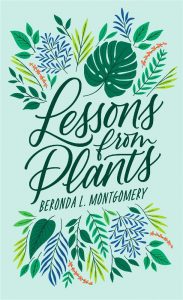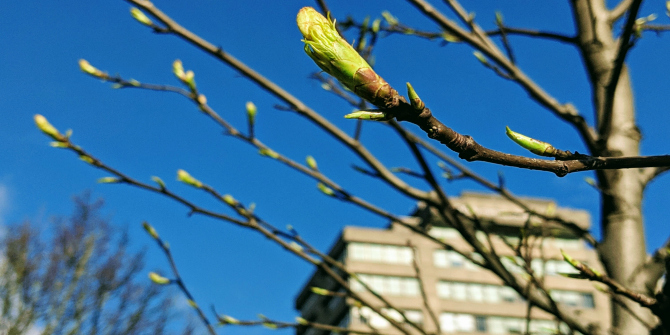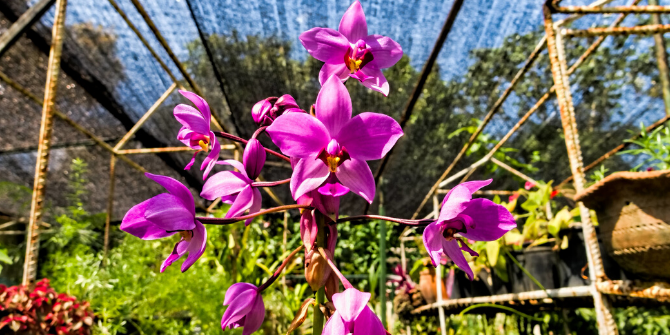In Lessons from Plants, Beronda L. Montgomery offers a deep engagement with plant lives, showing how growing our plant awareness can benefit our understanding of human societies and relationships. Inviting us to reflect on the biological and plant metaphors we think with in our everyday lives, this book shows the power of scientists writing about the inspiration that fuels their research, finds Anna Nguyen.
Lessons from Plants. Beronda L. Montgomery. Harvard University Press. 2021.
 Find this book (affiliate link):
Find this book (affiliate link): ![]()
During an online conversation between Dr Chanda Prescod-Weinstein and Dr Beronda L. Montgomery hosted by Schuler Books, Montgomery stated that there were two books in Lessons from Plants. It is, she noted, a biology book and a book with analogies with some illustrations that visualise particular processes. Further, Montgomery shared that she wrote her monograph with Black feminists in mind. Thus, the language of the book highlights Montgomery’s love for plants, science and maths, as she notes in the Preface, and the lessons learned from plants can be a reflection on other organisms, professional spaces, mentoring, equity, relationships and bridging professional and personal domains.
These parallel books are very apparent throughout the six chapters of Lessons from Plants, as Montgomery explains plants and plant lives in scientific terms while also circling back to the lessons she wishes to instil in readers, leaders and organisers. In the Preface, she writes that as a biology researcher in academic science, she was prepared to experience the expected norms of researching science via the structure of the scientific method, mentor future scientists and make some valuable contributions that extend our knowledge of how the world works (xi). What she did not expect, however, was ‘the transformative growth and knowledge’ gained ‘from methodical and systematic observation of biological organisms, especially plants’ (xi-xii).
Analogies and metaphors are plentiful in the book, and a careful reader must be able to discern which ones Montgomery is critiquing and which ones she prefers. In the introduction, Montgomery notes the obvious comparison between human-animal and human-plant relationships and suggests a ‘companion term that encourages deepening awareness and appreciation of the plants around us’ (3), foregoing ‘flora appreciation’ for ‘plant awareness’ (4).

Photo by Sarah Dorweiler on Unsplash
This latter concept of ‘plant awareness’ can also refer to plants as reactive and intelligent, the beliefs that they have knowledge of themselves to go about being and that they actively exist (10). Plants behave in a way that is reflective of their surroundings, an idea that has been challenged or slow for others to accept because plants lack a central nervous system, which other organisms with clearly definable behavioural traits have (11). Yet, Montgomery notes that some scientists have broadened their understanding of behaviour as ‘describing the ability to gather and integrate information about the condition of the external and internal environment and then using that information to alter internal signaling or communications pathways […] resulting in changes to growth or allocation of nutrients and other resources. With this understanding, the idea that plants can ‘‘behave’’ became more acceptable’ (11).
In Chapter Two, ‘Friend or Foe’, Montgomery examines how plants may be competitive. In a particular example, a plant may compete for light through lateral rather than vertical growth. Researchers have suggested that some plants – as well as insects, fungi and bacteria – may adjust their competitive or collaborative behaviour depending on whether their neighbours are close kin or share genetic likeness (41). But we can learn beyond individual or genetic relations through what she calls ‘network-based relationships’ (51). Such beneficial relationships are an ideal for ‘establishing an ecosystem of support, collegiality, and community’, Montgomery writes, adding that her own professional network has been enriched by those in and outside of her disciplinary focus (50-51).
At the end of this illuminating chapter, Montgomery applies another analogy between plants and human relations in the ever-present problem with higher education or professional networks: that individuals from marginalised, underrepresented or first-generation communities have been kept out of these networks and this exclusion has derailed their likelihood of achieving success (51). Further, community gardens, community-based mentoring programmes and collaborative professional work ‘offer a salient demonstration of the power of diverse communities’ (51). The ultimate lesson, here, is that the most effective networks are ones that create and maintain robust systems of communication and diverse interactions (52).
These networks and their lessons also show up in Chapter Four, where Montgomery discusses ecological succession in the context of transformation and tells the story of the Chernobyl trees and resilient pioneer plants. Researchers observed the trees’ ability to re-establish themselves despite the dire toxic environment of Chernobyl (73-75), and noted how processes of ecological succession (primary succession and secondary succession) and pioneer plants play a part in the changing structure of the ecosystem. Soil characteristics change, and individual plants of various species ‘adapt to the local environment through the processes of colonization, establishment, and growth and survival significantly affect the overall pattern of succession’ (77). Pioneer plants, or species that are able to grow in challenging environments and can acquire scarce nutrients, behave differently in the two different types of succession. The ecological lesson regarding pioneer plants is that ‘no two species can occupy the same niche (that is, play the same ecological role) in the same location; one will outcompete the other. The process by which one species replaces another during succession occurs at varying rates and affects the ultimate species diversity in a community’ (83).
Mixed metaphors continue to be on Montgomery’s mind, specifically the adage ‘bloom where you’re planted’. She argues this is misleading, for plants ‘don’t just function in their environment: they actively participate and transform it’ (91). The lesson to create institutional change:
promoting change in human environments requires similar skills to those that plants display during ecological succession. In human institutions, or ecosystems, effective initial leaders of cultural change function as pioneers. Identifying and supporting individuals who possess the characteristics needed to promote change successively and synergistically toward developing and sustaining a new ecosystem is critical (92).
Here, Montgomery envisions flourishing community development that rejects individualist exceptionalism.
Chapter Five may best summarise the possibilities of diverse knowledges and communities. Montgomery shares the valuable Indigenous intercropping techniques of the Three Sisters as a way to acknowledge traditional ecological knowledge and bridge gaps between knowledge systems that have always included relationality to kin and non-human species without co-opting them (99, 106). This practice, in which Indigenous peoples have planted beans, corn and squash together, is another example of her argument regarding collaborative effort between nature, plants and humans. Finally, in the conclusion, Montgomery asks us to move beyond the conventional understanding of kin. Noting the restrictive use of biological kin, she adds that humans value ‘functional kin’, which she views as ‘based on rather narrow definitions of shared ethnicity, race, gender, or socioeconomic status’ (142) that inhibit actual inclusive communities from flourishing and thriving in society, like plants.
It is hardly controversial nowadays to declare that science is neither apolitical nor neutral. Nor is it controversial to ask readers to think about the author of the text. In a Nature article titled ‘My Most Memorable Mentors? Plants’, Montgomery, a Black woman scientist and Professor, writes that she is ‘in the vast minority’ in her professional space. This is a space where, she further explains, scientists are trained not to write about the inspiration that fuels their research and to separate the personal and the scientific. Readers should view Lessons from Plants as a book that can and has done both of these diligently. If biological metaphors like ‘taking root’ and ‘uprooting’ are significant to us, Montgomery’s explorations and critiques may make us reconsider why these are some metaphors she and we think with.
Note: This review gives the views of the author, and not the position of the LSE Review of Books blog, or of the London School of Economics and Political Science. The LSE RB blog may receive a small commission if you choose to make a purchase through the above Amazon affiliate link. This is entirely independent of the coverage of the book on LSE Review of Books.







